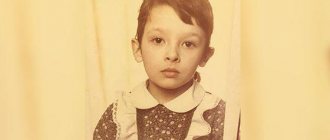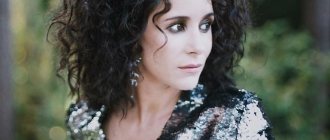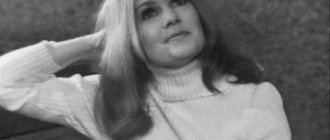Biography
Olga Lvovna Sviblova is a prominent person in the circles of the domestic cultural elite. The name of this woman is regularly included in the top 50 most influential people in Russian art. And in 2011, she entered the international ranking of the publication “Le journal des Arts”, becoming one of the hundred most authoritative people in world art.
Olga Sviblova was born in the summer of 1953 in Moscow into an intelligent family, where her mother was a philologist, a teacher of German at the university, and her father was an engineer in the space industry who worked at the Kurchatov Institute. At the same time, the family lived in a communal apartment, where there was not even a bathroom. But in the huge apartment there were many children, and in the yard with the old barn there were dogs, which little Olya adored. The girl even stated that when she grows up, she will become their shepherd.
Art critic and documentary filmmaker Olga Sviblova
At the age of 4, Sviblova fell ill with osteoarticular tuberculosis. She could move with great difficulty. Probably, it was then that Olga developed her character: in order to get on her feet and overcome the consequences of a terrible illness, she was forced to persistently play sports, overcoming pain and weakness.
The parents turned out to be wise people. They gave their daughter the opportunity to develop the way she wanted. There was never any pressure and there was freedom to act, right or wrong. This is how Olga Sviblova learned to think and choose.
Olga Sviblova
In high school at math school, Sviblova chose biology. She did it with ease, but was soon disappointed. The girl left, quitting biology after the 3rd year, and entered the psychology department of Moscow State University. She graduated from graduate school in 1987, defending her dissertation on the topic “Metaphorization of creative processes.”
Career
The biography of Olga Sviblova has been connected with art since the late 1980s. The story of the arrival of beauty in the world is quite simple and at the same time symbolic. In her youth, the girl saw strange people on the capital’s street who were different from the general gray mass. They had long hair and beards. Their clothes also made them stand out from the crowd. Having become interested in these subjects, the girl went after them, keeping her distance. This is how Olga first came to an exhibition of contemporary art. She liked the atmosphere and guests of the event so much that Sviblova began regularly attending such meetings.
Art critic Olga Sviblova
In the mid-1980s, Olga Lvovna herself began organizing art exhibitions. Today she is the curator of more than 500 projects, including contemporary art and photography.
In 1996, Sviblova founded the Moscow House of Photography, which today is called the Multimedia Art Museum. She also founded the “Art of the End of the Century” association and the Moscow School of Photography and Multimedia named after A. Rodchenko.
Olga Lvovna especially highlights the art of photography. Within the walls of the Multimedia Art Museum, which she heads, an exhibition of amateur photographs from the late 1980s was recently held. The unprofessional photographs that people brought turned out to be extremely entertaining in terms of reflecting the spirit of the past, the atmosphere and years when the era was rapidly changing. The interest in the exhibition was so high that it was recognized as one of the most successful at the Photobiennale.
The second half of the 1990s brought Sviblova a number of new creative tasks. Along with organizing exhibitions, Olga became the artistic director of the Moscow Photobiennale, the Silver Camera competition and the Fashion and Style in Photography festival.
Olga Lvovna Sviblova is also known as a film director. She has several works to her credit that have brought her fame far beyond the borders of Russia. Sviblova’s debut film is the film “Architect Melnikov”. A year later, in 1987, a painting called “Krivoarbatsky Lane, 12” was released. For this work, Sviblova was awarded a prize at the documentary film festival about architecture, which was held in Lausanne.
In 1988, the director presented the documentary film “Black Square” to the audience. The film tells about the Russian underground from 1953 to 1988. For it, Olga Sviblova was awarded the main prize of the Chicago Documentary Film Festival and the first prize of the Bombay Documentary Film Festival. But the most honorable and prestigious award is the “Golden Plate”. This is the Parisian critics' prize at the Cannes Film Festival.
In 1991 and 1995, Olga Sviblova presented two more documentaries - “In Search of a Happy Ending” and “Dina Verni”. These films also received prestigious Russian and foreign awards. The second film told about the life of the muse of the French artist Aristide Maillol, a member of the French “Resistance”, who was repeatedly saved by her patron. In memory of the artist, by 1995 Dina opened a museum dedicated to his work.
At home, the work of the art critic and director was appreciated: in 2001, Sviblova was awarded the Order of Merit for the Fatherland, II degree.
Art critic and documentary filmmaker Olga Sviblova
Since the 90s, Olga Sviblova has collaborated with French, British and Icelandic museums, regularly becoming a curator of exhibitions. Olga brings installations by Russian artists and photographers to the French capital, including Valery Koshlyakov, Maria Serebryakova, Sergei Chilikov, Alexander Rodchenko and others. At the Venice Biennale of Contemporary Art, Olga represented the Russian pavilion. With the participation of Sviblova, in 2020 the Pompidou Museum in Paris hosted the exhibition “COLLECTION! Contemporary art in the USSR and Russia 1950–2000: a unique gift to the museum”, organized by the Vladimir Potanin Charitable Foundation.
Olga Sviblova is famous for her own style, which she has developed over the years. Olga does not change her long-term habit of wearing spectacular jewelry in the form of massive necklaces and beads. At one time, the art critic regularly appeared wearing a pearl necklace, the base of which was made of mesh material. Later, Olga began to prefer beads made from large transparent balls, which she called soap bubbles. Sviblova first purchased them in Venice, in the shop of the sisters Marianne and Suzanne Saint. Thanks to Olga Sviblova, the collection became fashionable and brought financial success to the authors.
Documentary filmmaker Olga Sviblova
When it comes to clothes, Olga Lvovna prefers models from the collections of Japanese and Belgian fashion designers. Favorite color of wardrobe items is black. According to Sviblova, her taste was instilled in her by her mother, who took her to fashion shows at GUM as a girl. And in the summer, my parents brought things from Germany, which they saved for a whole year for tour packages. Thanks to her mother, Olga learned to find branded items in thrift stores. She cures any depression by going to a second-hand store, so that the “treatment” does not turn out to be ruinous. And since childhood, Sviblova has not thrown away clothes, but remade them, because she believes that with an outfit she is buying a part of herself.
Filmography
Director and scriptwriter
- 1986 - “Architect Melnikov”[5]
- 1987 - “Krivoarbatsky Lane, 12” (a prize at the festival of documentary films about architecture in Lausanne).
- 1988 - “Black Square” - a film about Russian underground art from 1953 to 1988[5] (Paris Critics' Prize at the Cannes Film Festival, "Golden Plate" - the main prize at the Chicago Documentary Film Festival, first prize at the Bombay Documentary Film Festival, First Prize at the First All-Union Documentary Film Festival)[1].
- 1991 - “In Search of a Happy Ending”, a film about contemporary Russian art 1988-1991. (first prize in the documentary film competition at the Pompidou Center).
- 1995 - “Dina Verni” (prize at the UNESCO Film Festival in Paris).
Personal life
The art critic walked down the aisle for the first time at the age of 18. But this experience turned out to be sad. The approaching wedding day did not evoke delight and joy in the bride, but a desire to cancel everything. But the white dress was bought, the hall was booked, and there was nowhere to retreat. Olga realized that she was making a mistake on her wedding day. Therefore, she ran away immediately after the solemn announcement of the couple as husband and wife. Divorce followed 3 months later.
Olga Sviblova got married for the second time a few years later. Her husband was a talented and creative person, poet Alexey Parshchikov. In 1983, the couple had a son, Timofey. The couple lived together for 18 years, but eventually separated.
Olga Sviblova with her son
Olga Sviblova’s personal life developed happily after meeting and becoming acquainted with Olivier Morand, a Frenchman by nationality, owner of an insurance company, director of the La Base exhibition center in Paris and her like-minded person. My husband passed away in 2014. There were no children in the third marriage.
Olga Sviblova’s son, Timofey Parshchikov, graduated from the cinematography department of VGIK and studied at the higher courses for directors and screenwriters. Later he became a famous photographer in Moscow.
Projects
| This article or section contains a list of sources or external references, but the sources of individual statements remain unclear due to a lack of footnotes. Claims that are not supported by sources may be questioned and removed. You can improve the article by providing more accurate citations to your sources. |
Curator, co-curator and coordinator Olga Sviblova, King of Spain Juan Carlos I and President of the Russian Federation Dmitry Medvedev at the Moscow House of Photography
- 1984 - curator of one-day art exhibitions of youth contemporary art in the exhibition hall of the Moscow Union of Artists on Kuznetsky Most;
- 1987 - curator of film and poetry programs as part of the 17th youth exhibition on Kuznetsky Most;
- 1988 - curator of the 1st festival of Russian avant-garde art in Finland and the exhibition “Three Generations of the Rodchenko Family”, Imatra, Finland[9];
- 1988 - “Igor Ganikovsky”, Julia Tokaer gallery, Paris; “Evgeny Dybsky”, gallery “Kai Forsblom”, Helsinki; “Igor Ganikovsky”, Pelin Gallery, Helsinki; visiting professor at the Royal Academy, Amsterdam;
- 1989 - exhibition of Icelandic artists, Museum of Decorative and Applied Arts, Moscow; exhibition of Russian artists at the International Festival of Contemporary Art in Glasgow; “Irina Zatulovskaya”, gallery “Kai Forsblom”, Helsinki; “Zakhar Sherman”, Pelin Gallery, Helsinki; “Sergey Shutov”, gallery “Kai Forsblom”, Helsinki;
- 1990 - exhibition of Russian artists at the National Gallery of Iceland, Reykjavik; exhibition of Ukrainian artists, gallery “Kai Forsblom”, Helsinki; exhibition of Georgian abstractionists, gallery “Kai Forsblom”, Helsinki; “Francisco Infante”, Kai Forsblom Gallery, Helsinki; “Art as money, money as art”, World Economic Forum, Davos, Switzerland;
- 1991 - curator of the RINACO corporate collection; “Common Land” / “Common Land”, a joint English-Russian project in six UK museums: Peterborough Museum, Art Gallery; Aberdeen Art Gallery; Grundy Art Gallery; Wakefield Museum and Art Gallery; York City Art Gallery; Salford Museum and Art Gallery; Usher Gallery; creation and general artistic direction of creative workshops in Trekhprudny Lane, start of the program “Art as pleasure, pleasure as art”: the program existed for two years, and a new exhibition opened every Thursday; “Art as power, power as art”, exhibition of contemporary Russian artists, Central House of Artists, Moscow; “Donald Judd”, Exhibition Hall of the Cultural Foundation, Moscow;
- 1992 - exhibition of contemporary Russian art, Caisse des Depots et Consignations, Paris; “Valery Koshlyakov”, La Base Center for Contemporary Art, Paris;
- 1993 - exhibition of corporate collections of international contemporary art Caisse des Depots et Consignations, Central House of Artists, Moscow; "Francisco Infante", La Base Center for Contemporary Art, Paris; “Anatoly Zhuravlev”, La Base Center for Contemporary Art, Paris;
- 1994 - “Maria Serebryakova”, La Base Center for Contemporary Art, Paris; “Oleg Vasiliev”, La Base Center for Contemporary Art, Paris; group exhibition of contemporary Russian art, La Base Center for Contemporary Art, Paris;
- 1995 - “Igor Shelkovsky”, La Base Center for Contemporary Art, Paris;
- 1996 - “Islamic Project” of the AES+F group, La Base gallery, Paris; group exhibition of contemporary Russian photographers, La Base Center for Contemporary Art, Paris;
- 1997 - “Photographs of Alexander Grinberg 1920-1930s”, Black Square gallery, Paris; “Photographs of Yuri Eremin 1920-1930s,” Black Square gallery, Paris; “Alexander Viktorov”, Black Square gallery, Paris; art director and curator of the festival “Moscow through the eyes of Russian and foreign photographers”, 72 exhibitions, Moscow;
- 1998 - “Photographs of Max Penson 1920-1930s”, Black Square gallery, Paris; “Photographs of Mikhail Dmitriev at the end of the 19th - beginning of the 20th centuries,” Black Square gallery, Paris; “Igor Mukhin”, Black Square gallery, Paris; “Olga Chernysheva”, Black Square gallery, Paris; “The History of Moscow in Photographs”, Musée Carnavalet - Musée de l'Histoire de Paris, Paris; “Soviet photography - a mirror of its time”, exhibition hall Pavilion des Arts, Paris;
- 2000 - “Soviet photography is a mirror of its time. 1917-1991", Helsinki Art Museum
- 2002 - “Photoprovocations” by Sergei Chilikov, festival “International Photographic Meetings in Arles”; “Max Penson. Retrospective”, “International Month of Photography in Paris”, exhibition hall of the Historical Library, Paris; “New style in Russian photography”, “International Month of Photography in Paris”, exhibition halls of the National Archives, Paris; “From pictorialism and modernism - to socialist realism. Soviet photography 1920-1930s", Museum of History, Vienna;
- 2003 - “New Beginning / Contemporary Art from Moscow”, Kunsthalle, Dusseldorf; “Sergey Chilikov”, “International Month of Photography”, Rome “Russian Photography. Retrospective”, Art Museum, Reykjavik; “Modern Russian photography. 1991-2003", Frankfurt am Main;
- 2004 - “Soviet photography of the 1920-1930s”, Fotomuseum Winterthur, Winterthur;
- 2005 — “Silent resistance. Russian pictorialism. 1900-1930s", Fondazione Scientifica Querini Stampalia Onlus, Venice; "Alexander Rodchenko. Moscow Postcards” as part of the “European Month of Photography”, Jewish Museum, Vienna; "Dmitry Baltermants. Retrospective”, European House of Photography, Paris; “Street, Art and Fashion” as part of the EUROPALIA.RUSSIA 2005 festival, Antwerp Photo Museum, Antwerp; “Russian view of Europe” as part of the EUROPALIA.RUSSIA 2005 festival, Brussels; Photographic section of the exhibition “Avant-garde. Before and After” as part of the festival EUROPALIA.RUSSIA 2005, Palace of Fine Arts, Brussels; “Invasion” as part of the 1st Moscow Biennale of Contemporary Art, Moscow;
- 2006 - “Visual weapons. Soviet photomontage 1917-1953", Passage de Retz, Paris;
- 2007 - “Max Penson. Retrospective" as part of the festival "ACT 2006. New Russian Art in London", The Gilbert Collection, Somerset House, London; “Sorrowless Paradise…” group AES+F, Passage de Retz, Paris; "Alexander Rodchenko. Revolutionary view", Musee d'art moderne de la ville de Paris, Paris; Russian pavilion of the 52nd Venice Biennale of Contemporary Art (artists: Yulia Milner, Alexander Ponomarev, Andrey Bartenev, Arseny Meshcheryakov, group “AES+F”), Venice;
- 2008 - “Sorrowless Paradise...” group AES+F, MACRO, Rome; “Visa to Russia: land and soul” by Mark Vinogradov, Passage de Retz, Paris; "Alexander Rodchenko", Hayward Gallery, London; "Alexander Rodchenko", Martin-Gropius-Bau, Berlin; “Silent resistance. Russian Pictorialism 1900-1930s”, within the framework of the Russian-Latvian seasons, Museum of Decorative and Applied Arts of Latvia, Riga; “Silent resistance. Russian Pictorialism 1900-1930s", Museum of Modern Art, Istanbul; “Photomontage in the USSR. 1920-1950s", Photo Museum of the Canary Islands, Tenerife;
- 2009 - curator of the Russian Pavilion of the 53rd Venice Biennale of Contemporary Art (artists: Pavel Pepperstein, Irina Korina, Sergey Shekhovtsov, Georgy Ostretsov, Anatoly Zhuravlev, Alexey Kallima, Andrey Molodkin), Venice[11].
- 2016 - curator of the exhibition “ COLLECTION!”
Contemporary art in the USSR and Russia 1950–2000: a unique gift to the museum ", a gift to the Pompidou Center from a group of domestic collectors gathered under the auspices of the Vladimir Potanin Charitable Foundation, Pompidou Center, Paris









